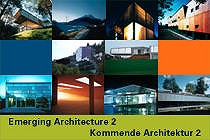
|
Emerging Architecture 2 - Kommende Architektur 2 10 More Austrians Location: Architekturzentrum Wien - Old hall Exhibition: 06 December 2001 - 15 April 2002 Opening Hours: Daily 10:00 am - 7:00 pm Opening: Wednesday 5 December 2001, 7pm Flöckner Schnöll Architects Saint-Julien-Strasse 9a A - 5020 Salzburg AUSTRIA Phone +43-662-87 87 99 Fax +43-662-87 87 99 atelier@floecknerschnoell.com www.floecknerschnoell.com Flöckner Schnöll Architects on "nextroom - architektur im netz" (in german) Maria Flöckner born in Salzburg in 1962. Studied architecture from 1982–90 at the TU Vienna. Worked with A. Schweighofer (office and at the TU Vienna, Institute for Building Construction). Traveled through Asia and Africa. Board Member, 'Initiative Architektur', in Salzburg from 1998–2000. Hermann Schnöll born in Salzburg in 1964. Studied architecture from 1983–84 at the TU Vienna and from 1984–90 at the University of Applied Arts in Vienna under H. Hollein. Founding member of 'Dynamo' in 1985. Since 1998 joint office Maria Flöckner und Hermann Schnöll. Buildings, projects (select): 1997 Werfenweng Center, competition (with T. Forsthuber and G. Zich); Gendarmery Boat-lifting Facility, project (with T. Forsthuber), Mattsee 1998–2000 Taxham Day Home for Children (Salzburg Prize for Architecture 2000; Austrian Clients Prize 2000; Salzburg Energy Prize 2001; Salzburg Prize for Woodwork 2001) 2000–01 Zenzmaier House and Studio, Kuchl; all in Salzburg Optimized Cover, Innovative Spaces Sustainable constructional concepts, passive- and low-energy houses are indeed the dictates of the hour. The recipe of compact, high-insulated constructions, however, frequently leads to reduced, sculptural, functional interactions between constructions and their environments. Flöckner Schnöll projects show fascinating alternatives to such stereotypes. They link efficient energy concepts and up-to-date modes of construction with innovative spatial solutions. Here, to optimize a building's envelope is in agreement with an enrichment of the volumes' interior complexity, whereas such an inner development, a conversion of conventional types of buildings, does not stop at the individual object. Rather, it is followed up as a principle of entire development structures. [...] |
 |
|
|
|
Current Preview Permanent Exhibition Emerging Architecture 2 - Kommende Architektur 2 Press Release 10 More Austrians * cukrowicz.nachbaur * fasch&fuchs. * Flöckner Schnöll Architects * Hans Gangoly * gerner°gerner plus * Erich Gutmorgeth * HOLODECK.at * MARTERERMOOSMANN * Gerhard Mitterberger * Wolfgang Tschapeller E-Shop Products: Book: Emerging Architecture 2 / Kommende Architektur 2 DVD: Emerging Architecture 2 - Kommende Architektur 2 Information: Ines Purtauf Tel.: +43 (1) 522 31 15 - 25 Fax: +43 (1) 522 31 17 Email: purtauf@azw.at |
| © Architekturzentrum Wien 2025 |
||



